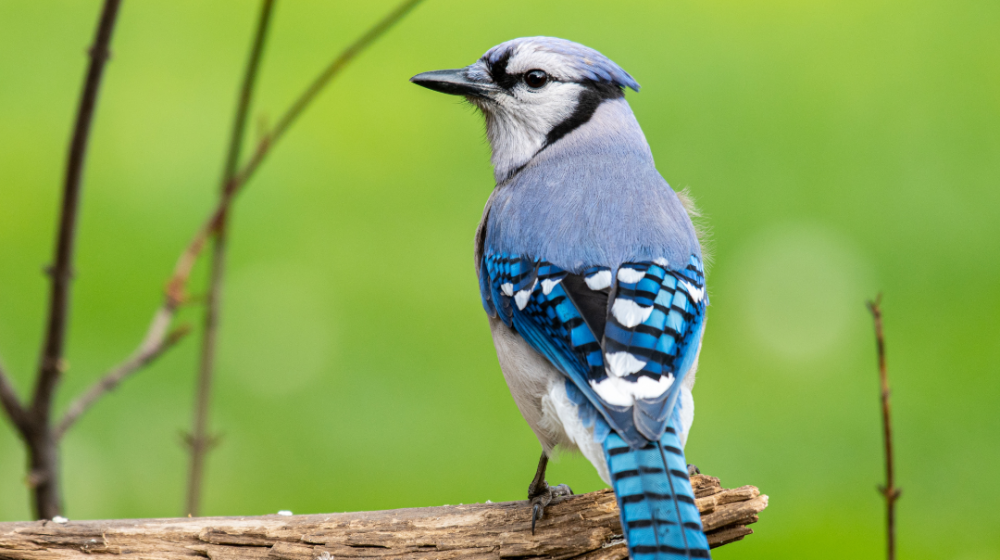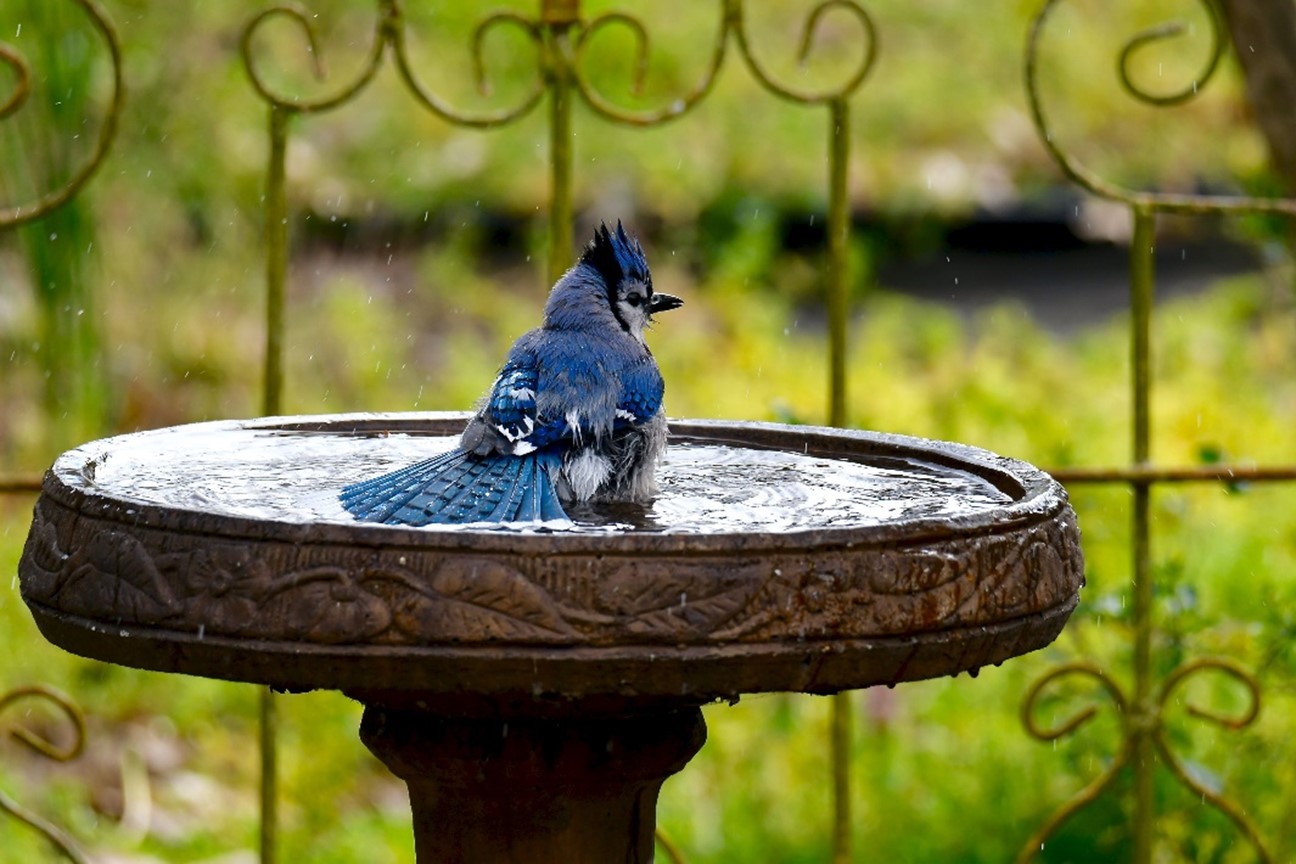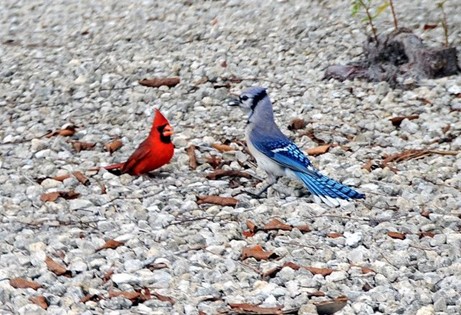As spring unfolds, bringing vibrant colors and melodies, many of us look forward to the arrival of our feathered friends.
Among the most sought-after backyard visitors are the striking Cardinals and Blue Jays.
This guide explores effective strategies to attract Cardinals and Blue Jays to your yard, enhancing your outdoor space with their presence and song.
Why the Blue Jay?

Blue Jays, known for their vibrant blue plumage and lively nature, are a delightful sight in many parts of the eastern and central United States.
Contrary to the belief of their rarity, these birds are quite common in their range, especially during spring.
Understanding how to attract Cardinals and Blue Jays can enrich your garden with their colorful presence and melodious calls.
Let’s delve into how to make your yard more inviting for these beautiful birds.
How to Spot the Blue Jay?
Recognizing Blue Jays is key to understanding how to attract Cardinals and Blue Jays to your yard.
The Blue Jay is easily identifiable by its striking blue, white, and black plumage.
Their backs and wings are vivid blue, while their chests and tails often feature prominent white patterns.
A notable feature is the black ‘necklace’ marking around their necks.
Additionally, their crested heads, with tufts of feathers, are a distinct trait, often raised or lowered based on their alertness.
The wings also have beautiful patterns of white and black, adding to their distinctive appearance.
How do you Attract the Blue Jay Bird to Your Lawn?

Start with the right food to successfully learn how to attract Cardinals and Blue Jays.
Blue Jays are particularly fond of nuts. Offer a variety of unsalted, unseasoned nuts such as peanuts, almonds, and pecans.
Avoid salted or spiced nuts, as these are not suitable for bird consumption.
While having a yard near woods or forested areas increases your chances of seeing Blue Jays, you can still attract them in other settings.
Consider installing a hopper or tray feeder, as Blue Jays prefer these overhanging feeders.
Besides nuts, Blue Jays are also attracted to a range of foods like acorns, safflower seeds, suet, fruits, mealworms, cracked corn, and especially sunflower seeds.
Remember, the key to attracting these birds is a steady supply of their preferred foods in a feeder that suits their feeding style.
Planting native trees such as oaks can be a long-term strategy to attract Blue Jays, as they are drawn to acorns.
Consider species like the Oregon white oak, but ensure that your yard’s conditions and regional climate suit these deciduous trees.
In addition to food, water sources are essential. Blue Jays, like many birds, enjoy bathing and drinking fresh water.
A large birdbath can be particularly attractive, especially if designed to accommodate multiple birds.
Pedestal baths serve the needs of Blue Jays and add an aesthetic element to your garden.
Remember, a yard mimicking a bird’s natural habitat, with food and water sources, is more likely to attract and retain Blue Jays.
Once Blue Jays visit your yard, observing them from a distance is important. These birds are cautious and can be easily disturbed by human presence.
If approached too closely, they may feel threatened and avoid your yard. Respecting their space is key to maintaining their regular visits.
Blue Jays are territorial, particularly regarding their food and offspring. Avoid close interactions to prevent them from feeling encroached upon.
Additionally, managing potential competitors, like squirrels, is crucial. Squirrels can dominate feeders and deter Blue Jays.
Ensuring your squirrel-proof feeders helps maintain a welcoming environment for the Blue Jays, allowing them to feed without competition.
Why the Cardinal as Well?

Cardinals, admired for their striking red plumage, are a beloved sight in many American yards.
These robust, seed-eating birds, with their strong beaks, are often found in the northern and southern regions of the United States.
Males are particularly notable for their vibrant red feathers and a distinctive black mask around the face, which resembles a patch.
The females, though less brightly colored, have a beautiful mix of warm reddish hues, grays, and browns.
Understanding how to attract Cardinals and Blue Jays can add a vivid and melodious dimension to your garden.
How Can You Spot A Cardinal?
Spotting a Cardinal is straightforward once you know what to look for. These birds are easily recognizable by their long tails and distinctive postures.
Often, they are seen in a hunched-over position, which prominently displays their tails and the striking color patterns on their backs.
Cardinals are known for their thick bills and prominent crests.
The males stand out with their deep red plumage, while the females are more subdued, sporting pale yellow or brownish tones with hints of red.
Identifying these birds is an important step in learning how to attract Cardinals and Blue Jays to your yard.
How do you Make Sure Cardinals Come to Your Yard?

To effectively attract Cardinals, consider the type of feeders and food you offer.
Cardinals prefer feeders, such as hopper or platform feeders, where they can perch and feed comfortably.
These feeders allow them to face forward and maneuver easily while eating, which is their natural preference.
The key to attracting Cardinals is providing their favorite foods. They primarily feed on seeds and can husk and hull most varieties with their strong beaks.
The top choices for Cardinals include safflower seeds and various types of sunflower seeds, particularly the black oil sunflower seeds.
These seeds are a favorite due to their high-fat content and easy-to-crack shells.
Striped sunflower seeds, with their harder husks, are also attractive to Cardinals but less accessible to smaller, less robust birds.
When setting up feeders to attract Cardinals and Blue Jays, ensure they are stocked with these preferred seeds and placed in areas that offer shelter or cover for these birds.
The placement of feeders is crucial for attracting Cardinals. Feeders should be located near sheltered areas such as trees and shrubs.
This provides a sense of safety from predators and offers a comfortable, cool environment for the birds to feed.
Strategic feeder placement can significantly increase the likelihood of Cardinals visiting your yard.
In addition to food, water is essential. Like many other bird species, Cardinals require a steady supply of clean water for drinking and bathing, especially in warmer regions.
Consider adding a water source like a birdbath or a water fountain in your yard to attract Cardinals and Blue Jays.
Regularly change the water to keep it clean and free from bacteria and algae.
For added comfort, place a few sticks or rocks in the water to provide perching spots for the birds.
By addressing both the feeding and water needs of Cardinals, you can create an inviting habitat in your yard.
Keep your feeders consistently stocked to ensure Cardinals become regular visitors, especially during winter.
Cardinals are non-migratory birds and remain in the same area year-round.
A reliable food source is crucial during harsh weather conditions, providing sustenance and comfort.
Ground feeding can also be encouraged, as Cardinals often feel secure foraging under the cover of shrubs and plants.
However, moderation is key to avoiding becoming too dependent or altering their natural foraging behavior.
A diverse landscape with various layers, including ground cover, perennials, shrubs, and trees of different sizes, creates an ideal habitat.
This variety offers safety and encourages Cardinals to consider your yard for nesting.
While Cardinals generally do not use birdhouses, providing nesting materials can be beneficial.
Offering items like small twigs, yarn, or pet fur in accessible areas near feeders can encourage them to build nests nearby.
This way, you might even see these beautiful birds take up permanent residence in your yard.
Conclusion
In conclusion, attracting Cardinals and Blue Jays to your yard can be a rewarding experience, bringing you closer to nature’s splendor.
Remember, the key is to create a welcoming and safe environment that caters to their needs, with the right feeders, food, and habitat.
While these winged visitors may bring some natural untidiness, the joy and beauty they add to your garden far outweigh any minor inconveniences.
Embrace the opportunity to observe these magnificent birds and enjoy the vibrant life they bring to your outdoor space.
Happy birdwatching!


Very informative